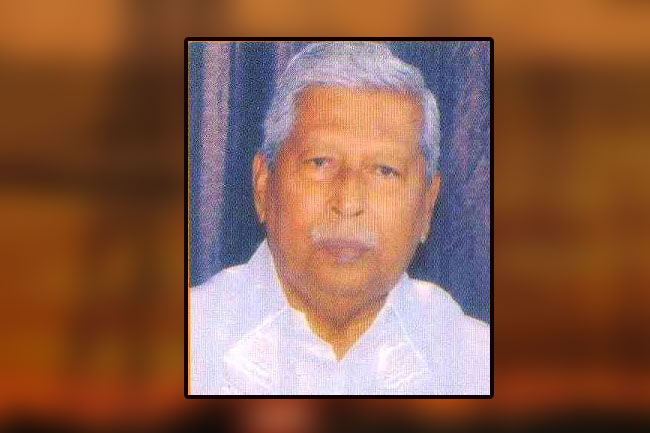One of best development administrators SL ever had
Source:Island
Mr. K. Thayaparan (KT), who retired from the government service after serving as a development administrator for more than thirty years passed away on Jan 05 at the age of 86. He was born in 1937 in Malaya, which was then under the British rule; his father had migrated there in 1916 for employment. His father was employed in the Malayan Railways, and the family was living a happy life. In the late 1940s, there erupted a terrorist movement launched by Communists of Chinese origin. To fight with the terrorists the British Government had issued a conscription order for all school leavers above the age of 17 years to join the military. Many families with male children over 17 years fled to Ceylon to avoid conscription. Since KT’s family also had a male child who had been noticed to report for military duty, his family members too other than his father left Malaya in 1951 and came to live in Ceylon. In Jaffna, KT resumed and completed his school education. In 1958 he entered the University of Ceylon at Peradeniya to undertake studies in geography, economics and history.
During the university days, KT had won university colours in badminton. He graduated in 1961, and served as a school teacher in the Matara district. In 1962, after sitting a competitive examination, KT joined the Government Divisional Revenue Officers’ service. In 1963, together with the other officers of the DROs’ service and comparable services, KT was absorbed into the Ceylon Administrative Service that had been created in place of the Ceylon Civil Service, which had simultaneously been abolished.
Till 1975 KT served in the district administration in the northern districts, first as DRO, then as Asst. Government Agent and as Addl. Government Agent. From 1976 to 1979 he worked in the Ministry of Fisheries as Deputy Director Planning, and contributed to the development of the National Fisheries Development Plan 1979 – 1983. The Fisheries Development Plan, among other activities had concentrated on exploitation of the fish resources in the Sri Lanka’s exclusive economic zone, which was proclaimed in 1977, and utilisation of irrigation reservoirs and village tanks for development of inland fisheries. The Government made a policy decision to implement an accelerated programme to develop inland fisheries and aquaculture. For this purpose, a new Division called the Inland Fisheries Division was set up in the Ministry, and KT was appointed its director.
The accelerated development programme had a number of activities to perform. Establishment of fish breeding stations in different parts of the country, recruitment and training of scientific and technical officers to serve at fish breeding centres, import of exotic fish species suitable for culture in Sri Lankan inland waterbodies, training of youth in inland fishing and aquaculture, promotion of investments in shrimp farming, etc. Funding agencies like UNDP, ADB and individual countries on bilateral basis came forward to support the accelerated inland fisheries development programme by providing funds for development of infrastructure, providing technical assistance, providing foreign training for the scientific and technical staff who were mostly young people without experience, and providing advisory services. It was heavy work for KT, but he managed the Division and its work smoothly.
KT was a firm believer in team work. He knew workers in all outstation inland fisheries or aquaculture establishments by name. He distributed foreign training slots offered by donor countries or agencies to every scientific or technical officer on an equitable basis. He listened to everybody, and was quite loved by his staff. KT was quite neutral in politics. However, in spite of his hard work to develop the inland fisheries sector, he was transferred out of the Ministry in 1985 to the SLAS Pool.
In 1979 when KT took over the responsibility of developing inland fisheries and aquaculture in the country, the total national inland fish production in Sri Lanka was 17,400 tons. During his tenure of nearly six years, the national inland fish production steadily increased and in 1985, the year he was transferred it had increased to 32,700 tons, showing an increase of nearly 90%. Also, there were 4,500 inland fishing craft operating in reservoirs, and the number employed as fishers, fish collectors, fish traders, etc. was over 10,000.
After leaving the Ministry of Fisheries he served different assignments such as Director Regional Development, National Consultant or the World Bank funded Reconstruction, Rehabilitation and Resettlement Project, Secretary to the North-East Provincial Council Ministry of Agriculture, Lands and Fisheries, and Secretary to the State Ministry Hindu Religious and Cultural Affairs. In 1995, he was appointed Addl. Secretary Development of the Ministry of Fisheries, but his stay in this post was brief since the then Minister replaced him with one of his political supporters. His last government assignment was as Addl. Secretary, Ministry of Plan Implementation, National Integration and Ethnic Affairs. In 1997, he retired from the government service, but continued in a few foreign funded projects as institutional development consultant. He once told that his most productive period in the government service was as Director Inland Fisheries. After retirement he authored several books, Reminiscences of Malaya 1937 – 1951, Stories of Some Brave Men and High Achievers, and Introduction to Some Known High Achievers.
Although he was quite suitable to be appointed the Secretary to a Ministry, he was never considered for such a post. In the final years of his career, he was compelled to serve under his juniors. But he carried on regardless and did the best in whatever the capacity he served.
Hettiarachchi








